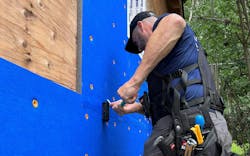CI with Integrated Air Barriers Solve Building Envelope Challenges
How Integrated Continuous Air Barriers Solve Building Envelope Challenges
Striving to meet IECC codes and home performance standards like HERS®, ENERGY STAR®, and Zero Energy Ready Home (ZERH), home builders are increasingly challenged to create tighter seals around the homes they construct. Choosing the right combination of building envelope products is crucial. For many builders, meeting stricter codes and standards requires not only the right products to meet new and changing codes, but also solutions that are easy to install and reduce complexity. Builders now must deliver the efficiency required but also address day-to-day constraints like tight construction schedules and skilled labor shortages.
One important requirement impacting how home builders approach the building envelope is the number of air changes a home can have per hour to meet codes and standards. Air infiltration has a major impact on home efficiency, as each air change represents energy expenditure to condition the air. A home’s ACH50 rating is a factor in determining if a builder is meeting the IECC code for their state and climate zone.
ACH rate requirements continue to become more stringent
The 2012 IECC marked the start of mandatory blower door testing for new residential construction and the requirement has remained. Air leakage rates in the 2021 IECC, for instance, cannot exceed five air changes per hour (5 ACH50) in Climate Zones 0 through 2 or three air changes per hour (3 ACH50) in Climate Zones 3 through 8 when tested in accordance with the code.
The upcoming 2024 IECC just released this month increases the stringency of the prescriptive air leakage rate requirements in some climate zones. Climate Zones 0-2: are going from a 5 to a 4 ACH50, Climate Zones 3-5: will see not change and remain at 3 ACH50 while Climate Zones 6-8: are going from 3 to a 2.5 ACH50.
As a result, builders need highly effective solutions for creating a continuous air barrier to achieve lower ACH50 rates. The challenge for home builders is how to create a continuous air barrier that is sealed tightly enough to achieve their ACH goals while managing the practical constraints of home construction.
Integrated Continuous Air Barrier Products Satisfy Multiple Building Envelope Needs
A continuous air barrier is typically formed by a mix of building envelope products that combine to create an uninterrupted seal around a home. Many factors can influence a builder’s choice, such as:
- Number of products to create a continuous air barrier. Many different product combinations can create a continuous air barrier, and each requires specific tools and equipment, installation methods, and skill sets. As the number of products increases, so too can the complexity, skill level, and labor required for installation.
- Cost in relation to return. The cost of a continuous air barrier includes not only products but also time, tools, and labor. It’s common for builders to know how much it costs to earn each additional HERS point for a home.
- Availability of skilled labor. The skilled labor shortage continues to impact virtually every decision for home builders, driving them to seek simpler solutions that require less manpower and expertise.
Taking these factors into consideration, manufacturers are now introducing integrated continuous air barrier solutions that accomplish weatherizing, insulating, and sealing tasks with one panel and one trip around the home.
One new building envelope product that highlights the benefits of an integrated continuous air barrier solution is Blueskin® VPTech™ from Henry®. This lightweight 4’ x 8’ panel combines a self-sealing and drainable weather-resistive barrier (WRB), Type II nominal 1” R5 graphite polystyrene (GPS) continuous insulation (CI), and seam sealing. The key to its effectiveness in creating a continuous air barrier lies in its pre-applied vertical and horizontal seam-sealing flaps that make it easy to achieve a uniform seal that is both air- and water-tight. Installers simply peel off the release liner and press the adhesive flap onto the adjacent panel to create a continuous seal.
This kind of integration is revolutionary for the continuous air barrier, enabling builders to meet or exceed stringent ACH ratings and energy codes more quickly and easily while reducing skilled labor requirements and cutting installation time. With one product and one pass around a home, builders can install a WRB and CI — and seal the panels to create an airtight envelope without using separate seam-sealing tape. With Blueskin VPTech, this integration represents an up to 30% reduction in installation time without requiring any special skill, technique, or equipment.1 Advantages like these are helping builders better handle labor issues and construction schedules as well as deliver the high-performance, energy-efficient homes that keep them profitable.
¹During trials with independent building contractors, Blueskin VPTech installed 30% faster than continuous insulation and WRB installed as separate components.


